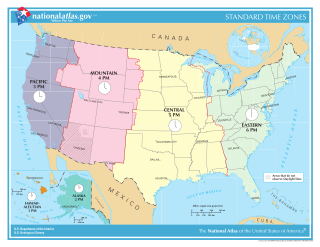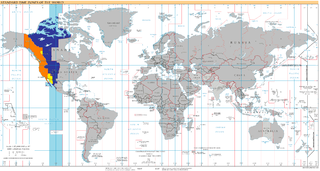This article needs additional citations for verification .(January 2021) |
This article needs additional citations for verification .(January 2021) |
Yukon Standard Time is the informal name of a time zone established in 2020 and used in the territory of Yukon in Canada. "Yukon Standard Time" is more formally referred to as year-round Mountain Standard Time (MST) but unlike other Mountain Time (MT, or MST/MDT) regions it does not observe daylight saving time, giving it a year-round calculation by subtracting seven hours from Coordinated Universal Time (UTC) resulting in UTC−07:00. [1] This time-zone is also used in northeastern areas of British Columbia.
The previous Yukon Time Zone was a time zone in the United States and Canada. Yukon Standard Time (YST) was obtained by subtracting nine hours from UTC resulting in UTC−09:00. [note 1] Yukon Daylight Time (YDT) when observed was eight hours behind UTC. In 1983, the United States restructured the UTC−09:00 based time zone and renamed it to Alaska Time Zone in 1984. [2]
When it was created[ when? ], the Yukon Time Zone included Yukon, and a small region around Yakutat, Alaska (Alaska had been spread across four different time zones at the time).
Yukon, which had adopted Yukon Standard Time in 1900 observed a one-hour advance in 1918 and 1919, and again year-round from February 1942 to September 1945 (Yukon War Time then, after V-J Day, Yukon Prevailing Time).
In 1965, from the last Sunday in April to the last Sunday in September, double daylight time – a two-hour advance – was observed. On July 1, 1966, most of the Yukon switched to Pacific Standard Time (PST), which is UTC−08:00, leaving Dawson City and Old Crow on Yukon time. The remaining area changed to the Pacific Time Zone on October 28, 1973, leaving only Yakutat on the Yukon Time Zone.
On October 30, 1983, coincident with the end of daylight saving time, Alaska switched in 1983 from four time zones to two time zones. [3] The areas east of Yakutat set clocks back two hours to change from Pacific Daylight Time to what had been Yukon Standard Time, UTC−09:00, and the time zone was named Alaska Standard Time at the end of November 1984. [2] Yakutat only set clocks back one hour on that date. Most of the remaining longitudes of Alaska left their clocks unchanged on that date, changing from Alaska-Hawaii Daylight Time (UTC−09:00) to the new Alaska Standard Time (UTC−09:00). Some areas that had been on Bering Time (UTC−11:00 in winter, UTC−10:00 in summer) such as Nome set their clocks ahead yet another hour on October 30, 1983 to adopt Alaska Standard Time (the former Yukon Standard Time), effectively changing their standard time zone by two hours. Most of the Aleutian Islands moved from the Bering Time Zone (UTC−11:00) to the Hawaii-Aleutian Standard Time Zone (UTC−10:00) (which was known as the Alaska-Hawaii Standard Time Zone until 1984. [2] )
In a motion brought forth in May 2017, the government of Yukon Territory began the process of ending the Daylight Saving Time changes in the territory. DST changeover was officially ended in Yukon on November 21st, 2020. [4] This change re-established Yukon Standard Time as being a distinct time-zone from Pacific Time (PT, or PST/PDT).

A time zone is an area which observes a uniform standard time for legal, commercial and social purposes. Time zones tend to follow the boundaries between countries and their subdivisions instead of strictly following longitude, because it is convenient for areas in frequent communication to keep the same time.

The Eastern Time Zone (ET) is a time zone encompassing part or all of 23 states in the eastern part of the United States, parts of eastern Canada, and the state of Quintana Roo in Mexico.

The Mountain Time Zone of North America keeps time by subtracting seven hours from Coordinated Universal Time (UTC) when standard time (UTC−07:00) is in effect, and by subtracting six hours during daylight saving time (UTC−06:00). The clock time in this zone is based on the mean solar time at the 105th meridian west of the Greenwich Observatory. In the United States, the exact specification for the location of time zones and the dividing lines between zones is set forth in the Code of Federal Regulations at 49 CFR 71.

The Pacific Time Zone (PT) is a time zone encompassing parts of western Canada, the western United States, and western Mexico. Places in this zone observe standard time by subtracting eight hours from Coordinated Universal Time (UTC−08:00). During daylight saving time, a time offset of UTC−07:00 is used.

The Alaska Time Zone observes standard time by subtracting nine hours from Coordinated Universal Time (UTC−09:00). During daylight saving time its time offset is eight hours (UTC−08:00). The clock time in this zone is based on mean solar time at the 135th meridian west of the Greenwich Observatory.

The Hawaii–Aleutian Time Zone observes Hawaii–Aleutian Standard Time (HST) by subtracting ten hours from Coordinated Universal Time (UTC−10:00). The clock time in this zone is based on the mean solar time of the 150th meridian west of the Greenwich Observatory.

In the United States, time is divided into nine standard time zones covering the states, territories and other US possessions, with most of the country observing daylight saving time (DST) for approximately the spring, summer, and fall months. The time zone boundaries and DST observance are regulated by the Department of Transportation, but no single map of those existed until the agency announced intentions to make one in September 2022. Official and highly precise timekeeping services (clocks) are provided by two federal agencies: the National Institute of Standards and Technology (NIST) ; and the United States Naval Observatory (USNO). The clocks run by these services are kept synchronized with each other as well as with those of other international timekeeping organizations.
Time in New Zealand is divided by law into two standard time zones. The main islands use New Zealand Standard Time (NZST), 12 hours in advance of Coordinated Universal Time (UTC) / military M (Mike), while the outlying Chatham Islands use Chatham Standard Time (CHAST), 12 hours 45 minutes in advance of UTC / military M^ (Mike-Three).

The Atlantic Time Zone is a geographical region that keeps standard time—called Atlantic Standard Time (AST)—by subtracting four hours from Coordinated Universal Time (UTC), resulting in UTC−04:00. AST is observed in parts of North America including several Caribbean islands. During part of the year, some portions of the zone observe daylight saving time, referred to as Atlantic Daylight Time (ADT), by moving their clocks forward one hour to UTC−03:00. The clock time in this zone is based on the mean solar time of the 60th meridian west of the Greenwich Observatory.

The Newfoundland Time Zone (NT) is a geographic region that keeps time by subtracting 3.5 hours from Coordinated Universal Time (UTC) during standard time, resulting in UTC−03:30; or subtracting 2.5 hours during daylight saving time. The clock time in this zone is based on the mean solar time of the meridian 52 degrees and 30 arcminutes west of the Greenwich Observatory. It is observed solely in the Canadian province of Newfoundland and Labrador. The Newfoundland Time Zone is the only active time zone with a half-hour offset from UTC in the Americas.

UTC−11:00 is an identifier for a time offset from UTC of −11:00. This time is used in Niue, American Samoa, Swains Island, and parts of the United States Minor Outlying Islands. This is the latest inhabited time zone, meaning this is the last inhabited time zone to celebrate the New Year, as the world's latest time zone (UTC-12:00) occurs only in strict nature reserves, such as Howland and Baker Island.

UTC−07:00 is an identifier for a time offset from UTC of −07:00. In North America, it is observed in the Mountain Time Zone during standard time, and in the Pacific Time Zone during the other eight months. Some locations use it year-round.

Australia uses three main time zones: Australian Eastern Standard Time, Australian Central Standard Time and Australian Western Standard Time.

Canada is divided into six time zones. Most areas of the country's provinces and territories operate on standard time from the first Sunday in November to the second Sunday in March and daylight saving time the rest of the year.

The Samoa Time Zone or Samoa Standard Time (SST) observes standard time by subtracting eleven hours from Coordinated Universal Time (UTC−11:00). The clock time in this zone is based on the mean solar time of the 165th meridian west of the Greenwich Observatory.

The Chamorro Time Zone, formerly the Guam Time Zone, is a United States time zone which observes standard time ten hours ahead of Coordinated Universal Time (UTC+10:00). The clock time in this zone is based on the mean solar time of the 150th meridian east of the Greenwich Observatory.

Most of the United States observes daylight saving time (DST), the practice of setting the clock forward by one hour when there is longer daylight during the day, so that evenings have more daylight and mornings have less. Exceptions include Arizona, Hawaii, and the territories of American Samoa, Guam, the Northern Mariana Islands, Puerto Rico, and the United States Virgin Islands. The Uniform Time Act of 1966 established a uniform set of rules for states opting to observe daylight saving time.
Hawaii is in the Hawaii–Aleutian Time Zone and does not observe daylight saving time.
Daylight saving time in the Americas is the arrangement in the Americas by which clocks are advanced by one hour in spring and moved back in autumn, to make the most of seasonal daylight. The practice is widespread in North America, with most of Canada and the United States participating, but much less so in Central and South America.
Alaska is officially covered by two time zones - the Alaska Time Zone and the Hawaii–Aleutian Time Zone. The Hawaii–Aleutian Time Zone is used for the Aleutian Islands west of 169°30′W, and the rest of the state uses the Alaska Time Zone. The entirety of Alaska observes daylight saving time.